
Head Surgery Page Menu: 1 2 3 4 5 6 7 8 9 10 11 12 13 14 Next>>
Head Surgery During the Golden Age of Piracy, Page 11
Trepanning Post-Op: Cleaning Up the Trepanned Hole
The trepanning operation would have created a quantity of dust following the continual grinding
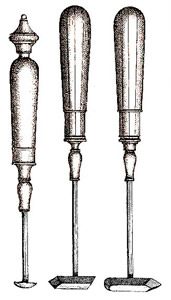
Leniculars for Removing Things,
From Opera di
Ambrogio Bertrandi,
Wellcome Collection (1786)
of the blade through the bone of the cranium. The hole left behind might also have rough edges, particularly if the bone had not been drilled completely through, but broken off as surgeons Pierre Dionis and Richard Wiseman had suggested. These things would have to be cleaned up after the hole was completed.
Wiseman says that if "the Membrane be fouled by the Saw dust of the Bone, you must wipe it off with a soft Sponge, or a little Lint upon your Probe."1 Sea surgeon John Atkins mentions using "an unctuous [oily] Syndon, (i.e. a Bit of fine Linnen cut round, and rather larger than the Perforation,) whose Edges may slide between the Skull and the Membrane, to catch abraded Dust and Particles."2 In one of his case studies, sea surgeon John Moyle recommends that "the Ramenta [shavings] were remov’d with a soft Linteolum [small linen cloths]; and the grumous [clotted] Blood was remov’d by Lint on the end of a Probe."3
Moyle also suggests using a lenticular to remove
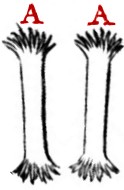
False Tents, A course of
chirurgical
operations,
Pierre Dionis, (1708)
"any extraniosities or asperities that may be fallen on the dura mater."4
Lenticulars used for this purpose were instruments with flat, smooth bottoms that were less likely to damage the brain (seen above left). If used with care, they could be dragged across the surface of the dura mater in a way that foreign objects would slide or be flipped on top of them. Then the instrument could be withdrawn to remove the detritus from the opening.
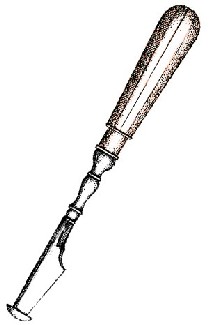
Leniculars for Scraping the Trepan Hole,
From Opera di
Ambrogio Bertrandi,
Wellcome Collection (1786)
This can be performed immediately upon completion of the operation. French surgical instructor Pierre Dionis advises the surgeon after he has trepanned the skull not to "wait till all the extravasated [leaking] Blood is come out,
'tis sufficient that it has a free Passage every Moment thro' the Orifice: We then clean out that which is in the hole in the Trepan, with the false Tents A A"5.
If the trepanned hole in the skull had rough edges, these had to be removed. Wiseman says the surgeon is "to smooth away the Asperity which remains in the lower Table by the Lenticular instrument made for that purpose"5. The lenticular used for scraping the edges of the bone in the skull was different than the ones that were used for removing dust and foreign particles from the brain. It had a smooth, curved surface on the bottom and a sharp, expanding angular edge which would match the angle of the sides of the hole left by the tapered blade as seen in the image at left. The cup-shaped bottom would also allow the edge to be slid under the cranium to collect falling dust and particles created by the scraping edge while the smooth bottom still protected the dura mater.
Both John Moyle6 and John Atkins agreed with Wiseman, with Atkins suggesting that "the Perforation is to be smoothed with a Lenticular"7.
1 Richard Wiseman, Of Wounds, Severall Chirurgicall Treatises, 1676, p. 381; 2 John Atkins, The Navy Surgeon, 1742, p. 87; 3 John Moyle, Memoirs: Of many Extraordinary Cures, 1708, p. 13-4; 4 John Moyle, The Sea Chirurgeon, 1693, p. 111; 5 Wiseman, p. 381; 6 Moyle, Memoirs, p. 14; 7 Atkins, p. 87
Trepanning Post-Op: Piercing the Brain
While much attention is paid to being careful not to pierce the brain, one surgical author from the period actually talked about doing so intentionally as a treatment of last resort. (A paragraph break has been added to this text to make it more readable.)

Artist: Pieter Jansz Quast
Operating, From Die Steinoperation (c. 1630)
It sometimes happeneth in great Concussions, that we lay open the Hairy scalp; and though we discover neither Fissure nor Fracture, yet we perforate the Cranium, to relieve the Patient: but if notwithstanding the Symptoms of Coma or Paralysis do not remit, you may shrewdly suspect the Extravasation [leaking] of bloud lieth deeper. For it sometimes happeneth in Concussions, that the extravasated bloud lieth between the Dura and Pia mater, and otherwhile amongst the Ventricles [cavities] of the Brain.
In which cases, if the Perforation of the Cranium relieve them not, you must take Apertion [an opening] through the Dura mater; and if the bloud lie between it and the Pia mater, it may haply be discharged. How that is to be drest, I shall shew you presently: but for the most part, the long retention of Matter sphacelates [rots] the Brain; and as the Patient suffered from the beginning under the severe Symptoms of Coma or Paralysis, so he dies at last Convulsive.1
This account comes from Richard Wiseman, who was primarily known as a land-based military surgeon during the English Civil War. He did serve shipboard in the Her Majesty's Navy, referring to some cases and operations performed there. However, an operation such as this one probably would be outside the experience and comfort-zone of most sea surgeons; a ship could be a particularly unstable platform from which to try to perform such a delicate procedure unless it was absolutely necessary.
1 Richard Wiseman, Of Wounds, Severall Chirurgicall Treatises, 1676, p. 383
Trepanning Post-Op: Raising the Skull
It was noted in the discussion in Non-Trepanning Treatments: Raising the Skull that
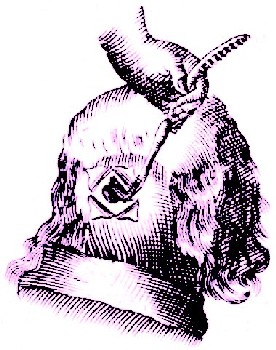
Artist: Jonas Arnold Delineavi
Raising the Skull with an Elevator, From l'Arcenal de
Chirurgerie,
By
Johannes
Scultetus, p. 116 (1665)
the surgeon sometimes needed to make another hole in the skull so that he could properly place his instruments under the skull. Although the procedure was very similar to those already discussed, examples of the surgeon raising the skull after trepanning had been performed to create room for the elevator are worth mentioning here to highlight it as a distinct operation from those where raising the skull was performed without the use of a trepan.
Sea surgeon John Moyle does not discuss raising the skull as a standalone operation in his book for sea-going surgical students. He does mention using an elevator (which he calls a 'Levetor') in one of his case studies to raise a depressed skull after trepanning.1 Unfortunately, he fails to provide the reader with further details of the procedure, perhaps deeming the raising of the skull with such an instrument to be obvious.
When discussing the method for treating a fracture in the skull, German surgeon Johannes Scultetus explains that when there is a crack in the middle of the depression, [it] is either broad or narrow... if it be narrow, the skull must be evenly terebrated [have a hole made in it], on the side of the crack that is sound and bare, with a Trepan, and must be lifted up by the help of Levitors [elevators]."2 Here again the details of the operation to raise the depressed skull are scant.
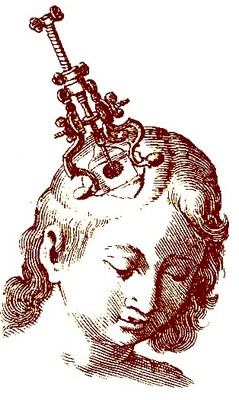
Artist: Jonas Arnold Delineavi
Terebra Use, Armamentarium Chirurgicum
Bipartitum,
Johannes Scultetus (1666)
Military surgeon Richard Wiseman gives what may be the most full and detailed account of this sort of procedure, including information on how the wound was to be finished and dressed.
I took off the Dressings, and set the Trepan above the fractured Bone, so to avoid the great Scar that must have been if I had set it below the Fracture, and considering withal the Poriness [porousness] of the Bone below. The Terebra [a screw-operated tool] set on, the Bone taken out, and the inner edges smoothed by the Lenticular instrument, I put in a Levator [elevator], and raised up the deprest Bone even with the rest: that done, I placed in a Sindon [medicated linen rag] dipt in ol. ros. [oil or roses] with a third part of Resin; then with a round Dossil [rolled piece of lint] filled up the Bore: after which I opened the Fissure with my Rugines [rasps], scraping away its edges, that no Sanies [serum, blood and/or pus] or Matter might be detained, and drest up the Bone with liniment Arcei [a mild stimulating liniment that promotes healing] warm, so as to give way to the Lips to fall in; I desiring no more Opening than was necessary for discharge of the Matter from within.3
Wiseman's use of the terebra to remove the bone chip is interesting. (See the image at right for an example of a terebra being used in a similar manner.) This instrument usually had three feet to give it a secure position on the skull. Different tools could be attached to the screw in the center including a drill, a threaded screw or a hooked foot which would serve as an elevator. According to his description, Wiseman must be using the screw to thread into the hole made by the pin in the bone chip. Once it was threaded securely in, he could extract it. None of the sea surgeons from this time mention the use or show images of this instrument in their texts, however.
1 John Moyle, Memoirs: Of many Extraordinary Cures, 1708, p. 14; 2 Johannes Scultetus, The Chirurgeons storehouse, 1674, p. 130; 3 Richard Wiseman, Of Wounds, Severall Chirurgicall Treatises, 1676, p. 392
Trepanning Post-Op: Dressing the Trepanned Hole
The recommendations for dressing a trepanned hole were in many ways similar to treating a fissure in the skull once the wounds in the dura mater had been dealt with and the fracture was cleaned up. However, some of the period surgeons discuss the particular method for medicating and dressing a trepanned hole, so their procedures are presented here.
John Moyle explains that once the hole is drilled through the skull,
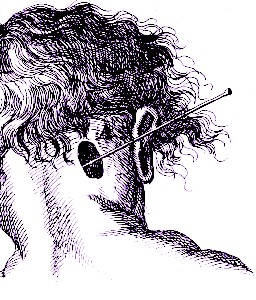
From Miscellanea Curiosa, sive Ephemeridum
Medico-physicarum Germanicarum (1700)
"there will come out abundance of contused blood; and (if the operation were neglected any time) of goary matter also."1 Once this discharge stopped, Moyle recommended washing the hole and membrane with a piece of absorbent cloth wrung out of 'Spirit. Vini rectisicandi'.2
The next step was to treat the dura mater membrane inside trepanned hole. John Atkins suggests using a 'Sindon' (medicated rag) wrung out of a mixture of 1/2 ounce of Resin and 2 drams of Oil of Roses with "a single Thread through the Middle, for the easier bringing it away." If the surgeon doesn't have the resin or oil of roses, Atkins advises using either Spirit Vini or Tincture of Myrrh combined with an equal amount of Honey of Roses.3
Richard Wiseman's recommendation agrees with Atkins' first suggestion: "I drest it up with a Sindon [medicated linen rag] dipt in ol. ros. with a little Resin warm."4 People observing the operation where he used this combination objected to it, "but I drest it up, and assured them that I would cure this Patient without applying any other Remedy to the Dura mater than these two simple Medicaments."5
Moyle similarly suggests using "a fine Cylendula [cylinder] of pure Lawn [linen cloth], and dipping it in warm Spirit of Wine [brandy], and Mel Rosar. [Honey of Roses] mixed, apply it smoothly to the bottom of your Perforation [trepanned hole]... you may with the point of your Probe, convey the edges of your Cylendula, even[ly] under the lower edges of the perforated bone."6
On top of the medicated cloth, both authors suggest putting on more cloth dressings. Atkins recommends the cloth be dry and used to fill up the hole to cover "the bared Cranium"7. Moyle recommends dipping the cloth in his mixture of brandy and honey of roses and filling the trepanned hole with that.8 Wiseman uses "a soft round Dossil next [to] the Sindon, and [medicated] the Bone with liniment. Arcei."9
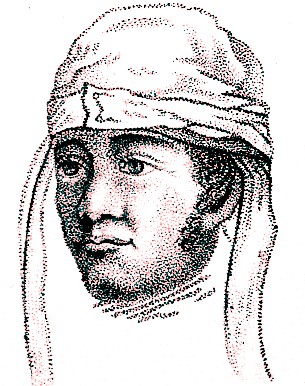
Artist: John Bell - Head Bandage, Wellcome (early 19th c.)
Once finished, a 'large and thick' Pledget [stopple of lint used to fill a cavity] is applied over the whole. For medicines, Atkins simply suggests using a Digestive - a medicine to promote flesh generation - without specifying a particular one.10 Wiseman recommends "an empl. de beton. mag. [plaster of betony] over all"11.
Moyle's suggestion is more complex. He advises using a "warm Catagmatick Balsam. 'Tis this; Rx. Terebinth Ven. [Venice Turpentine] {8 ounces} Gum Elem. [resin of Canarium luzonicum tree] {3 ounces} Resinæ {1.5 ounces}. Pulv. Aristoloch. rotund. [powdered root of Aristolochia rotunda] {1/2 ounce} Mastich, Oliban. Myrrh, {of each 1 dram} Sang. Dracon. {2 scruples} Croci [saffron] {1/2 dram} vitell. Ov. [egg yolks] {2 each} misce; f. Balsam [make into a balsam]"12.
Moyle recommends using this balsam throughout the healing process on the trepanned hole "till a new Skin has covered the Bone."13 Moyle then suggests rubbing the whole of the patient's head with oil of St. John's wort and then covering it with "a large Emplaster of Betonica or Paracelsus, very warm."14
Both surgeons advise placing a last bandage over their dressing. Atkins recommends "a good Compress, and the Head Bandage."15 Moyle suggests "a double bolster ...[and] on the Traphined place, a thin piece of Silver be placed in the bolster, to keep (when 'tis rouled upon) that a Fungus arise not through the Perforation [in the skull]. Then make good healing rouling".16 This silver disc may seem like a curious choice, but fellow sea surgeon John Woodall notes that "Silver [is used in] the cures of the infirmities of the head, and chiefely [cures] of the braine are ascribed"17. Today, silver is recognized as having antimicrobial properties, so it could have helped to prevent infection.18
1 John Moyle, The Sea Chirurgeon, 1693, p. 110-1; 2 Moyle,p. 111; 3 John Atkins, The Navy Surgeon, 1742, p. 87; 4 Richard Wiseman, Of Wounds, Severall Chirurgicall Treatises, 1676, p. 393; 5 Wiseman, p. 394; 6 Moyle,p. 111; 7 Atkins, p. 87; 8 Moyle, p. 111; 9 Wiseman, p. 394; 10 Atkins, p. 87; 11 Wiseman, p. 394; 12 Moyle,p. 111; 13,14 Moyle,p. 112; 15 Atkins, p. 87; 16 Moyle,p. 112; 17 John Woodall, the surgions mate, 1617, p. 240; 18 V. Edwards-Jones, "The benefits of silver in hygiene, personal care and healthcare", Letters in Applied Microbiology, Vol. 49 Issue 2, June 10, 2009, p. 147

